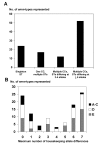Relationships between emm and multilocus sequence types within a global collection of Streptococcus pyogenes
- PMID: 18405369
- PMCID: PMC2359762
- DOI: 10.1186/1471-2180-8-59
Relationships between emm and multilocus sequence types within a global collection of Streptococcus pyogenes
Abstract
Background: The M type-specific surface protein antigens encoded by the 5' end of emm genes are targets of protective host immunity and attractive vaccine candidates against infection by Streptococcus pyogenes, a global human pathogen. A history of genetic change in emm was evaluated for a worldwide collection of > 500 S. pyogenes isolates that were defined for genetic background by multilocus sequence typing of housekeeping genes.
Results: Organisms were categorized by genotypes that roughly correspond to throat specialists, skin specialists, and generalists often recovered from infections at either tissue site. Recovery of distant clones sharing the same emm type was approximately 4-fold higher for skin specialists and generalists, as compared to throat specialists. Importantly, emm type was often a poor marker for clone. Recovery of clones that underwent recombinational replacement with a new emm type was most evident for the throat and skin specialists. The average ratio of nonsynonymous substitutions per nonsynonymous site (Ka) and synonymous substitutions per synonymous site (Ks) was 4.9, 1.5 and 1.3 for emm types of the throat specialist, skin specialist and generalist groups, respectively.
Conclusion: Data indicate that the relationships between emm type and genetic background differ among the three host tissue-related groups, and that the selection pressures acting on emm appear to be strongest for the throat specialists. Since positive selection is likely due in part to a protective host immune response, the findings may have important implications for vaccine design and vaccination strategies.
Figures

References
-
- Lancefield RC. Current knowledge of the type specific M antigens of group A streptococci. J Immunol. 1962;89:307–313. - PubMed
Publication types
MeSH terms
Substances
Grants and funding
LinkOut - more resources
Full Text Sources

